
THX Centre for Sound, Image and Digital Culture
Context
Focus
History
Model
Fields
Structure
THX Centre
Partners
Context
Following the termination of NIMk (Netherlands Media Art Institute) due to the cancelling of financial support by the Ministry of Culture, the institute tried to preserve the knowledge and experience that it had built up over the past 35 years. With this in mind and in consultation with other organisations, NIMk has developed a plan in order to transfer its knowledge, mandate and networks, and thus secure these for the future.
Under the name THX plans have been developed in consultation with STEIM towards a completely new centre for image, audio and digital culture in The Hague. THX aspires to be a platform for the creative industry: network, theatre, presentation and project space, laboratory (living labs), concert venue and online hub. THX strives to closely cooperate with V2_ Institute for Unstable Media in Rotterdam.
In addition to this focus on the public and participation, THX is a knowledge centre, production house and educational institution for higher and academic education in the fields of art, technology and life sciences. The ambition for the long term is to house THX on the Lange Voorhout in The Hague, in the building by Breuer that is now the American Embassy.
Presentation The Ministry of Education, Culture and Science
Since 1978, Montevideo and STEIM since 1967 have been investigating the consequences of the Digital Revolution—an upheaval that has morphed constantly over the years without the slightest diminishment of its dynamic power. Quite the contrary.
Activities
Museum – research institute – media art lab – collections – award – festival
Mirroring the networking that is the essence of our world, we are assuming the character of a network. The platform maintains contacts with thousands of artists, scientists, technologists, curators and activists all over the globe.
The nodes of this network are: the Collection, the Research and Education Centres; and the Centre, where the emphasis is on juxtaposing art and science in both the selection of content and how it’s presented. This specific orientation and the long-term continuity this institution has displayed make this Foundation an internationally unique platform for art and digital culture.
Both institutes are pioneers and internationally renowned and are now joining forces for a new centre for contemporary art and digital culture. Through strategic alliances with partners both from the art scene and the industry, this new institute is aiming to be a museum for the 3rd millennium.
Focus
Art – Science – Technology – Industry – Society
The two institutes are now joining forces to create a new platform for Art and Digital Culture. This platform assembles and configures the commentary, concepts and visions of our modern, information-based society, whereby currently prevailing facts & circumstances are always taken as points of departure for speculation about where we’re headed. In short: future manifestations that are presently in the process of emerging are what we are interested in. Attention is never focused singularly on art, science or society, but rather on their complex metamorphoses and interrelationships.
Innovation hub for cultural organisations
Innovation hubs can be especially important to cultural organisations wanting to expand funding streams and reduce their dependence on public funding and the advantages to the Dutch creative industries could be substantial.
An Initiative of the city of The Hague in close cooperation with the city of Rotterdam
The centre for Art and Digital Culture is a part of city development plans, city branding, a catalyst for regeneration in the city, showcasing it to the world as a hub of progress and innovation.
History
NIMk (Netherlands Media Art Institute), Amsterdam
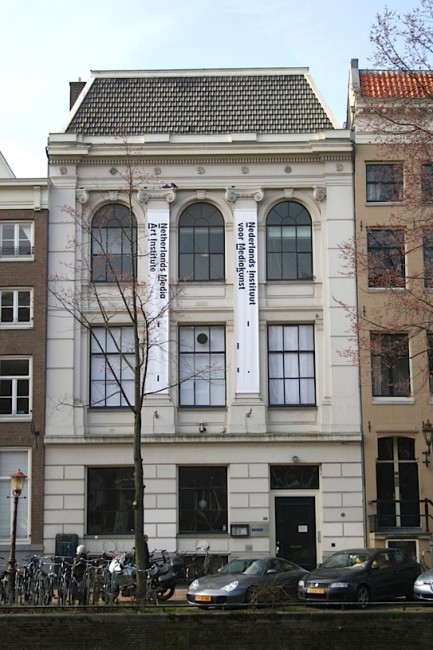
1978 Monte Video was founded by René Coelho. From his home on the Singel in Amsterdam he makes equipment and documentation available, and furnishes one room as a gallery. The first video artist whose work is shown here on the Singel was Livinus van de Bundt, Coelho’s inspiration. Other artists, such as Bill Viola, Gary Hill, Shelly Silver and Gabor Body, soon make contact. It is not long before Monte Video has a large selection of works available for rental.
1983 Thanks to government funding Monte Video is able to move to Amsterdam North. There is now sufficient space to offer regular presentations. Not only Dutch artists, but also those from other countries are given a chance to show their videos or installations.
1986 Government funding received by Montevideo is cut back to almost nothing. MonteVideo does receive several small transitional grants from the city of Amsterdam.
Time Based Arts, which had been founded in 1983 by the Association of Video Artists, is fast becoming well-known as a distributor of video art, and continues receiving government funding.
1986-1993 René Coelho continues on his own. MonteVideo moves back to his home on the Singel. The acquisition of production facilities, distribution, documentation and promotion goes on, financed from his own income and by organising large projects. One of these, as an example, was ‘Imago’, an exhibition of Dutch video installations which toured worldwide for five years beginning in 1990. There were also plans laid for the first conservation programs for video art.
The chairman of Time Based Arts, Aart van Barneveld, died; his death was followed by many conflicts within the organisation. In the early 1990s Time Based Arts also lost its subsidies and threatened to go under. Montevideo and Time Based Arts decide to provide a joint art program for Amsterdam cable TV, Channel Zero.
1993 Time Based Arts merges with Monte Video. Their work is continued under the new name of Netherlands Media Art Institute, Montevideo/ Time Based Arts. This fusion does free up national funding. In both 1997 and 2001 the grants were expanded and converted into a structural subsidy for four years.
1993-2009 The Netherlands Media Art Institute moved twice, in 1994 to the Spuistraat and in 1997 to its present location on the Keizersgracht. The Institute continues to grow through these years, and adopts the following mission statement: The NIMk (Netherlands Media Art Institute) supports media art in three core areas: presentation, research and conservation. At the same time, through its facilities it offers extensive services for artists and art institutions. Among these services are educational programs, to be developed to accompany all activities.
The Netherlands Media Art Institute (Montevideo) promotes the wide development, application and distribution of, and reflection on new technologies in the visual arts. The Netherlands Media Art Institute supports media art in three core areas: presentation, research and collection, and through its facilities provides extensive services for artists and art institutions. Associated with this are educational programmes, which are developed for all activities.
Presentation
The presentation department focuses on showing media art. Among other tasks, this division organises exhibitions in the Institute’s own gallery space. The long-running group and theme shows, such as solo exhibitions, retrospectives or shows in cooperation with other institutions, are museal presentations. They afford insight into an oeuvre or theme in a clear manner. Between the longer-running exhibitions there is room for more experimental presentations such as short exhibitions, symposia, screenings, live performances in image and sound, or test installations by artists and students. Activities are also organised outside our premises. This happens both on our own initiative and in collaboration with other organisations and art institutions.
Collection
Since the founding of the Netherlands Media Art Institute in 1978 an extensive collection of video and media art has been assembled, to which new works are continually being added. At present the collection comprises more than 1500 works, ranging from early experiments by artists now famous in The Netherlands and internationally to recent productions by up-and-coming talents. Almost all works, including the installations, are available for exhibitions and presentation both in The Netherlands and in other countries.
Distribution
In order to promote a wide public knowledge of media art, the Netherlands Media Art Institute carries on an active distribution policy. Video works and media installations from the collection are to be seen at Dutch and international festivals, events and exhibitions, in galleries, museums and other art institutions.
Research
The Netherlands Media Art Institute supports research by artists into the use of new media in the visual arts. Artists can be brought into contact with one another, collaborate, experiment, and create new work.
Conservation
Since 1992 the Netherlands Media Art Institute has developed into a centre of expertise for the conservation of media art. The Institute develops and performs research into models and theories in this field. Furthermore, it performs services in restoration and conservation for other public and private video collections.
Facilities and services
The Netherlands Media Art Institute performs a wide range of services: post-production, conservation and ICT, and provides advice to artists on technical questions.
Education
The Netherlands Media Art Institute has developed structural educational programs to accompany all of its core tasks. These provide a varied selection for various target audiences, including the general public, secondary schools, art academies and specialised groups such as artists, art historians and conservators.
STEIM, Amsterdam
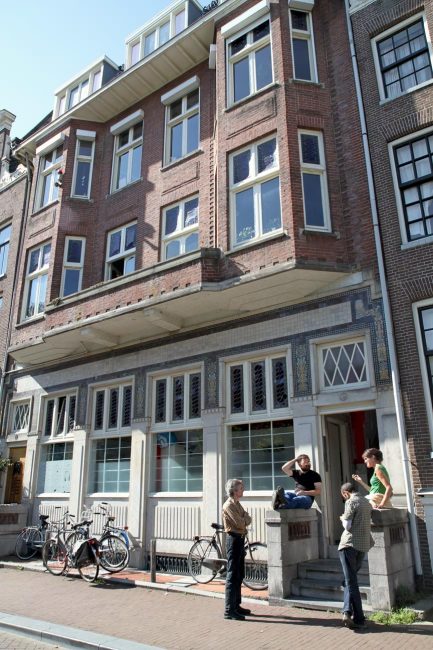
Now, with the more than a hundred musicians, artists, and scientists who visit STEIM every year, with the projects and residencies, the concerts and festivals, the development of hardware and software, and the function of STEIM as an international meeting place, it’s difficult to imagine that this cultural beehive was once, a bit more than 30 years ago, the modest initiative of a handful of Dutch composers.
Out of a kind of political and cultural rebellion, a workgroup was established in the autumn of 1967 by a few of the Netherlands’ most prominent and progressive composers: Peter Schat, Konrad Boehmer, Jan van Vlijmen, Misha Mengelberg, Louis Andriessen, Reinbert de Leeuw, and Dick Raaymakers. STEIM was created out of a dissatisfaction amongst composers and orchestral musicians with the fact that the products of the ‘isolated’ electronic music studio could only be heard in the concert hall via the static combination of magnetic tape and loudspeakers.
What the group had in mind was an electro-instrumental musical practice based on real-time processes. STEIM was created as a research laboratory and development workplace for live electronic music.
STEIM, a reconstruction by Roland Spekle, Michel Waisvis.
STEIM (the studio for electro-instrumental music) is the only independent live electronic music centre in the world that is exclusively dedicated to the performing arts.
The foundation’s artistic and technical departments support an international community of performers and musicians, and a growing group of visual artists, to develop unique instruments for their work. STEIM invites these people for residencies and provides them with an artistic and technical environment in which concepts can be given concrete form. It catalyses their ideas by providing critical feedback grounded in professional experience. These new creations are then exposed to a receptive responsive niche public at STEIM before being groomed for a larger audience.
STEIM promotes the idea that Touch is crucial in communicating with the new electronic performance art technologies. Too much the computer has been used, and designed, as an exclusive extension of the formalistic capabilities of humans. At STEIM the intelligence of the body, for example: the knowledge of the fingers or lips is considered musically as important as the ‘brain-knowledge’. STEIM has stimulated the design of extremely physical interfaces and is widely considered as the pioneering place for the new live electronic concepts.
STEIM has always encouraged the use of low-tech solutions and the creative “misuse” of recycled high-tech. STEIM stands for “a human approach to technology”. This technology has to be tailored to the individual. Unique instruments such as The Hands, The Web, The Sweatstick and the MIDI Conductor were created as a result of personal and individual projects but are now used by other performers.
STEIM‘s former director and founding father Michel Waisvisz (unfortunately passed away in 2008) is generally recognised as being the first to invent a practice for ecstatic live performance with live electronic instruments. Over the years a great variety of the pioneering artists of the live electronic performance arts have worked at STEIM. More recently STEIM is being discovered by DJ’s and VJ’s who want to liven up their act with physical control of their sound machines and laptops, also dancers, actors, visual artists and are coming up to STEIM to use the ideas found at STEIM and develop these further for there personal goals.
For many years, STEIM has nurtured a special line of activity where children are invited to play with its newly developed instruments. The playful, bright and inventive reactions of these children have often been of decisive importance in the process of creating playable electronic instruments. Since the mid-seventies STEIM has developed a series of tangible electronic devices that are intended not as toys but as instruments that have been ‘approved by children’. These include the Crackle Boxes and LiSa, the live sampler.
STEIM runs the Electronic musical instruments exhibition (formerly the Electro Squeek Club), an exhibition in the form of an arcade where visitors can playfully discover the major directions in the tactile approach within STEIM‘s instrumental objects.
V2_ Institute for Unstable Media, Rotterdam
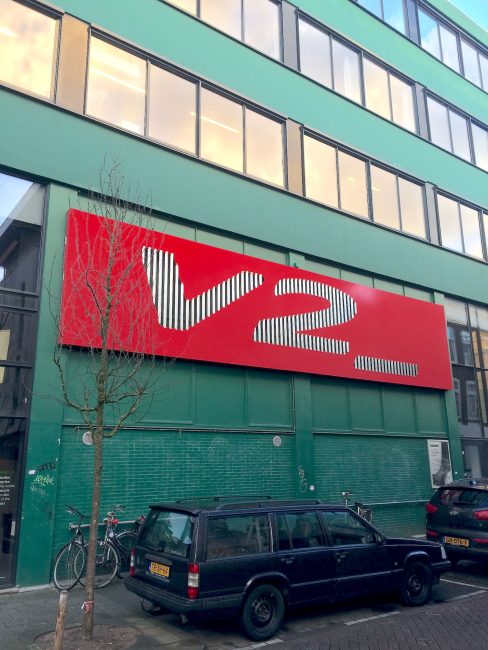
V2_ Institute for Unstable Media is an interdisciplinary centre for art and media technology in Rotterdam (the Netherlands).
Do-it-Yourself: 1981-1987
V2_ was founded in 1981 as an artist collective. A squat in the Vughterstraat 234 (short: V2_) in ‘s-Hertogenbosch, the Netherlands, accommodated artists from various disciplines. The founding members, including Alex Adriaansens and Joke Brouwer, named it a multimedia centre. The building gave room for concerts and performances and experiments with analogue media, like TVs, loudspeakers and Super-8 film. It also included an exhibition space for (wall) paintings, installations and machine art. Bands like Sonic Youth, Einstürzende Neubauten and Laibach performed at V2_ in the early days. It was a do-it-yourself period, where music, video, sound and visual arts were combined and the artists took the arts to the street.
Unstable Media: 1987-1993
The mid-eighties brought a turning point, not only for V2_, but for a lot of artists’ initiatives in the Netherlands. At the time, V2_ began transforming itself from a multimedia organisation into a centre for art and media technology. Because of dissatisfaction with the art practice of the day, the “Manifesto for Unstable Media” was issued by V2_ in 1987. It was intended to really ruffle the feathers of the visual arts. The Manifesto laid down the theoretical principles of V2_, also known since that time as the Institute for the Unstable Media. Though an historical document, most of what is in the Manifesto is still crucial for the work of the organisation.
In the next years, V2_ organised a number of “Manifestations for the Unstable Media,” which focused on the use of new technology and electronic media in the audiovisual arts. The festival showed interactive video and sound installations and experimented with robotics and the use of computers for generating electronic music and digital imagery. By organising public events and publishing books, V2_ also stimulated the debate on art, theory, technology and society.
Network and Communications Media: 1993-1998
In 1994, V2_ moved to its current location in the centre of Rotterdam, and since then concentrated on art in electronic networks and communications media, like the World Wide Web. Initially, artists only worked with text within the relatively small computer networks, but soon computer and telecommunication networks (ISDN) enabled them to work with sound and images. Artist began to explore the possibilities of computers as an artistic medium, using digital techniques, virtual reality and 3D projections to immerse users in cyberspace. During that time, V2_ developed itself into a professional organisation with an international network of contacts and Manifestation of the Unstable Media changed into the biannual Dutch Electronic Art Festival, where V2_’s network of artists, scientists and organisations from different disciplines could meet.
Art and Media Technology: 1998-present
The opening of the V2_Lab, an international media laboratory, in May 1998 meant an extension of V2_’s practices towards art production, research and knowledge exchange. In V2_’s interdisciplinary workspace, national and international artists, scientists and technicians collaborate on electronic art projects and technical research projects, for example hardware or open source software development. The often long-term research projects focus on the use of new technical possibilities for artistic means, research on the cultural and social implications of these techniques and the development of technically innovative (web) applications. They have resulted in software tools, but also in mixed media applications and interactive installations in public space. Apart from that, V2_ also organises workshops and expert meetings to exchange knowledge and experiences with other professionals.
Organising presentations, exhibitions and workshops, research and development of artworks in its own media lab, distributing artworks through its Agency, publishing in the field of art and media technology, and developing an online archive.
Model
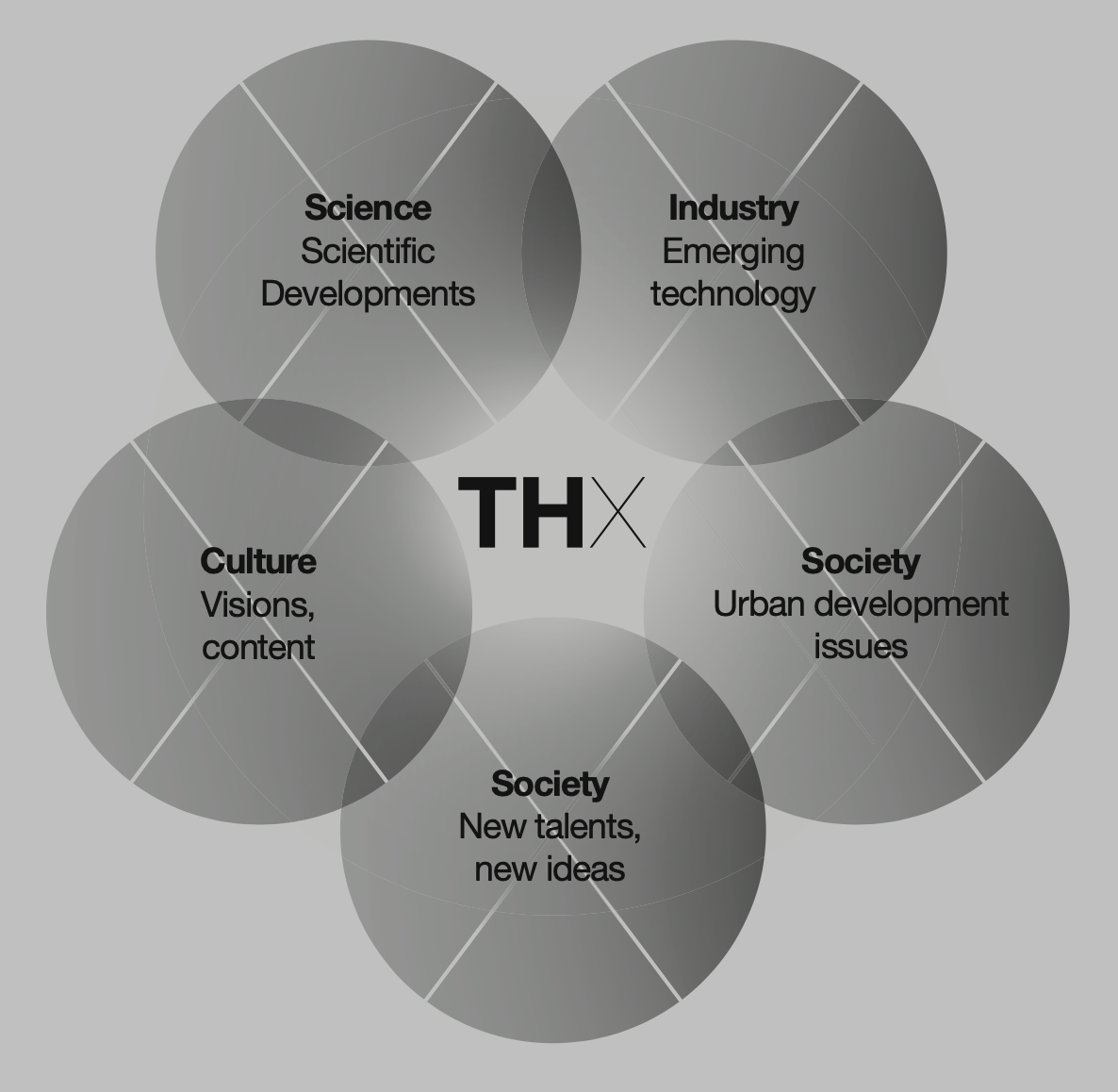
Produced in partnership with leading national and international institutions, THX will work in the fields of artistic, social and scientific research, production, presentation and distribution. It was established to both draw attention to and mobilize the unrealized innovative, artistic, and economic potential of joining important sectors: culture and education, science, industry and society.
At the heart of THX’s core values is the belief that research and innovation are the driving force behind creativity. Human futures – philosophic, scientific, social and artistic are the high level themes THX pursues in building creative and critical perspectives on the technologies that are being adopted in our societies.
Focus on life sciences
The spotlight isn’t exclusively on media art any more. The Museum’s activities are currently focused on the astounding progress being made in the life sciences and the momentous impact this is having on our view of the world and of humankind.The interface of art and science
More and more modern innovators are at home in multiple disciplines and genres simultaneously, combining artistic creativity with scientific skills. The bottom line: in an age of interdisciplinary R&D, it’s high time to take leave of traditional demarcations separating art and science. Put the accent on the shared presence of artistic and scientific pursuits. Neither an art gallery nor a science centre.For general audiences
All activities and offerings at the Center are designed to appeal to experts as well as laypeople, to be accessible by kids and grown-ups, young people and seniors alike.
Artist in residence studios
The Artist in Residence (AiR) programme supports the exploration and development of new work in digital/interactive/network media and technology based arts practice. The residency provides time and resources to artists in a supportive environment to facilitate the creation of new work. We encourage a cross disciplinary and experimental approach. This is a practice based residency designed to enable the development and completion of a new work.
A full-service accommodation facility for innovative, artistic and creative companies
Comfortable and professional offices, state of the art IT and telecom infrastructure, extensive meeting facilities
Economical, cultural and social added value
New partnerships, new opportunities: digital media businesses and cultural organisations as natural partners
Gaining commercial expertise/ Securing new revenue streams/ Securing technological expertise
Cutting costs, improving efficiencies and productivity/ Greater independence
Audience development, participation, engagement.
Participation, not just interaction
We’ve taken interaction—a revolutionary principle back in the 1990s—and expanded it into comprehensive participation. The centre’s mission is to serve as a setting for visitors to undertake hands-on experimentation and to enjoy eye-opening experiences.
Talent cloud
A consortium of organisations offer presentation opportunities to selected artists, researchers, and collaborative groups in multiple venues and festivals throughout the country and abroad.
Innovation hub
Aggregation and transfer of knowledge between emerging creative industries and art/tech school’s labs.
Fields
Urban innovation
Sustainable creative cities include understanding art as process (i.e. art as a verb, not only a noun), through infrastructural support, by engaging with spiritual/mental and physical/environmental contexts, how these elements are played out with individual and societal opportunities to learn skills in perception, and an ability to articulate and share common values such as creativity, conservation, expression and diversity. The process should be inclusive and genuinely participative allowing urban and non-urban actors to engage.
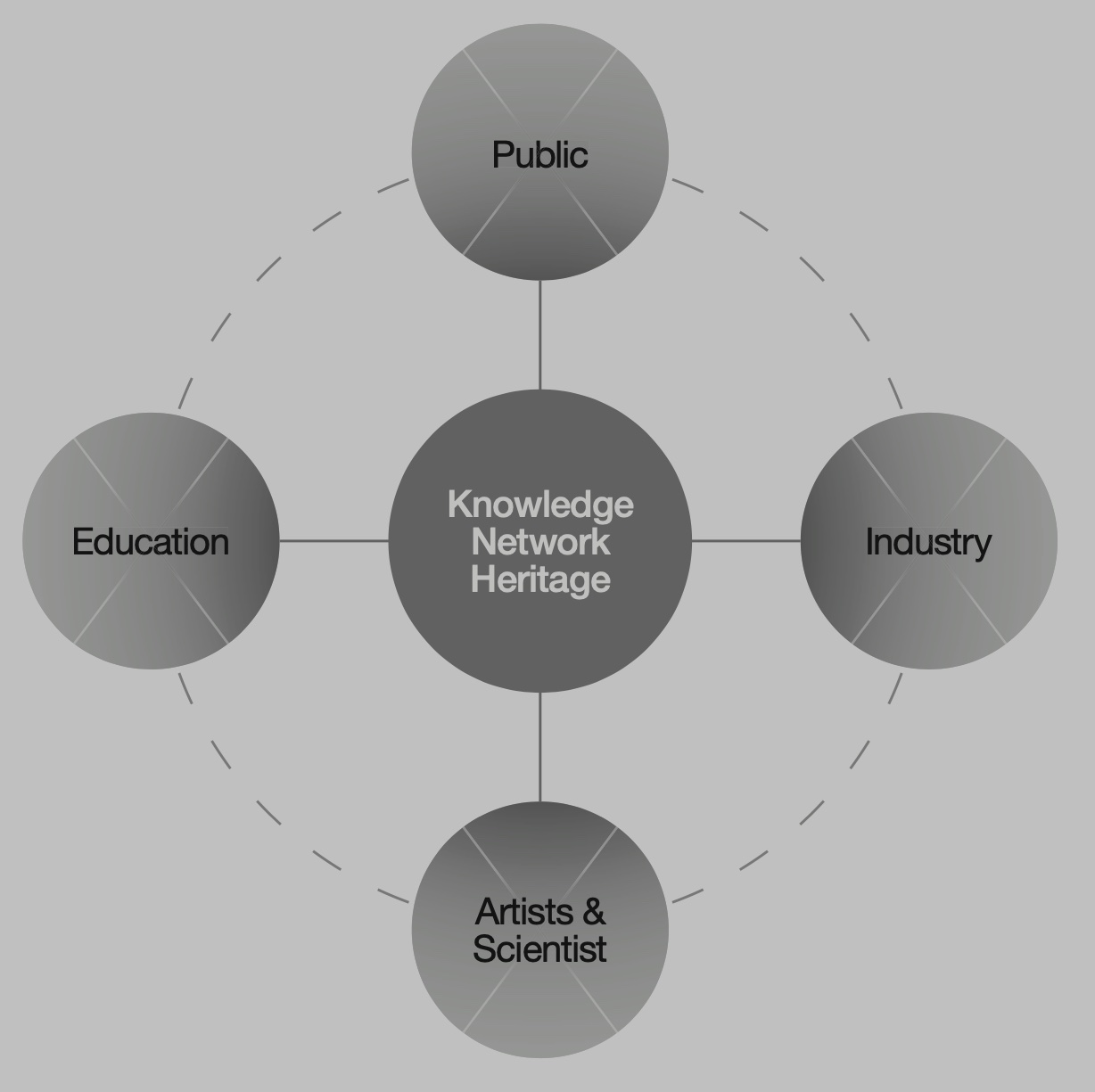
Our objectives
To organise a core of professionals, academicians and researchers with different professional, cultural and educational background for multidisciplinary urban research and analysis and elaboration of alternative urban policy models;
To stimulate a debate among the scientific community and cultural sector about the possibilities for introduction of alternative science-based approaches in urban planning and regeneration
To create a database of empirical results, research findings and examples of innovative urban planning and use of urban imagery which allows the identification of good/bad practices (and also examples of (un)successful urban identity formation) which can inform the civil society and relevant expert groups about the possibilities for urban regeneration policy. This database will be used for the production of a catalogue of good/bad practices in European and international urban regeneration.
To map the curriculum of existing education and training programs in the field of urban studies and to prepare a model for an interdisciplinary Post Graduate program in ‘Urban management and cultural policy of city’.
To raise awareness of the civil society about the potential of urban environment to be a factor of integration of certain social groups and subcultures on the territory of the city;
To create a bridge between the academic world and the urban policy-makers, by involving them into academic and research programs and sensitising them about existing innovative practices and shifts in urban planning and regeneration.
The need to “de-plannify” urban planning and about the value of, and need for more undesignated spaces in the city, where communities and creative practitioners can experiment more sustainable ways of life (by contrast to exceedingly planned creative/cultural districts).
*4th Connecting Civil Societies in Asia and Europe (CCS4) Conference. Workshop 3 | Sustainable Creative Cities: The role of the arts in globalised urban contexts. Briefing report.
Cultural Engineering
Trying to define ‘cultural innovation’ we can assume that innovative elements in cultural events can be discovered not only in experimental cutting-edge artistic works, but in a broader sense in many different aspects of cultural life in modern cities:
– in new artistic synthesis and interdisciplinary approaches;
– in the discovery of new stages for innovative or even traditional artistic forms;
– in the development of new audiences; in the participatory planning and implementation of artistic projects in the urban environment; more generally, in the enrichment of artistic projects with new social functions.
From such a point of view, cultural innovations foster access to culture and inclusive societies; make citizens more sensitive and aware of the quality of their public space; create benchmarks of the places we live in and enhance their attractiveness and revitalization.
Our objectives
Finding methods to involve the cultural sector in education and training, from early ages to life-long learning perspectives, and new ways of promoting culture and arts in formal and informal education.
Finding new ways of capacity-building of the cultural sector by for example additional training in managerial skills, entrepreneurship, project management.
Finding good examples and best practices of new alliances between the cultural sector and other sectors.
To discuss how a new infrastructure should be formed around the cultural sector to sustain growth, but also the intriguing question of how an economically viable sector can be built with a retained artistic integrity.
Focused on how art can be not only a way to express feelings, emotions and ideas but also a way to create meaning in a certain place and time through creative expression, keeping things dynamic and evolutionary. Art can be an experimental and rule-breaking process based on subversive imagination, creating messages that articulate contemporary discussions. It can question existing assumptions and make independent suggestions concerning societal issues, and offer alternatives.
Art, as a verb, should not be understood as limited to a specific sector of society (i.e. the arts), but professionals who do work in the artistic sector can be catalysers for others to become reflective practitioners. Artists can open up new worlds of possibilities and spaces for dialogue, sharing their creative thoughts with communities. Artists can work in service to society and contribute to long-term social transformations through creative forms of education.
The necessity to reorient keywords from dominant discourses (such as “growth”) away from their unsustainable meanings (e.g. quantitative economic growth fuelling a society of hyper-consumption) and towards more sustainable alternatives (e.g. a more qualitative and more spiritual idea of growth, better embedded in the imperatives of ecological resilience);
The strategic importance of fostering transversal social-ecological dimensions not only across small arts and cultural organizations, but also in existing/established larger art/cultural organizations;
How to best stress our opposition to cultural policies supporting grandiose “flagship” art, generating superficial image-returns for city marketing, narrowly elitist “art for art‟s sake” and creative industries serving globalized markets within a short-sighted competition between cities;
The challenge of achieving genuinely participative processes on the ground, and about the modalities and extent to which artists should and could be engaged in transforming urban development policies.
The dynamics of European cities in a range of contrasting contexts, related to inclusion-exclusion of various cultures and subcultures in public spaces of modern cities requires closer attention in order to understand contemporary processes of socio-cultural change and the potential for managing such change in the urban environment.
Current enlargement and integration processes suggest the need to rethink the implications of the new multicultural context, particularly with regard to minimizing the negative effects of this new cultural situation of constantly growing and less manageable diversity. Arts and creative activities are of profound significance in this process of promotion of inclusive citizenship as instruments for social activation and reintegration, due to their value added to stimulate positive cultural identities and to afford opportunity for self-expression and self-determination of different sections of the population, including various disadvantaged groups.
Successfully nurtured sustainable and resilient creative economies. How cultural entrepreneurs are operating to change cities and regions after the downturn.
Structure
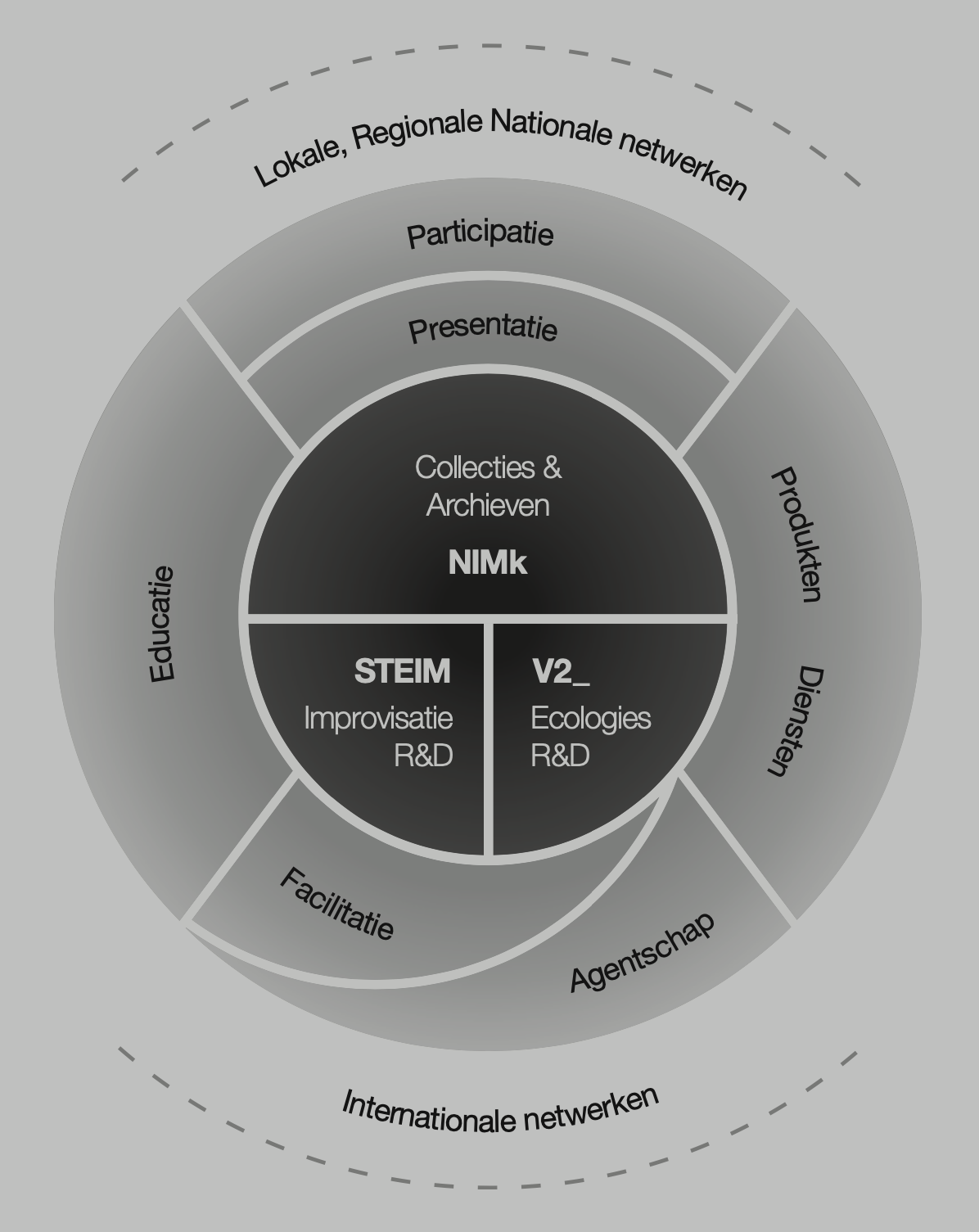
Foundation
The foundation operates as a cultural body to serve the general interest, as well as the governing body of the THX .
Montevideo and STEIM are the two parent organisations of the Foundation for Art, Science and Society, having separate legal identities.
To ensure unity of governance and management, they have the same board of directors and are linked by strategic agreements.
The foundation operates on a non profit basis and is controlled by an independent board.
Mission
Generating innovative ideas that reflect an evolving understanding of art, and engaging some of the best creative minds in the business. THX is dedicated to finding modern solutions to foster, produce, promote and distribute original, artist-driven projects.
THX explores new trends and develops inspiring foresights on art, technology and society. For that purpose THX facilitates a free space in which enthusiastic stakeholders meet and construct creative views on the future. The results serve as starting points for new initiatives, such as research and educational programs as well as a museum, a club, a food lab, a medialounge and several events and festivals.
THX Centre
Museum
The prototype of Tomorrow’s Museum will utilise new media in unprecedented ways and, with its superb exhibitions and ground-breaking methods of presenting and imparting content blaze innovative trails into the future.
The institute will continue its pioneering attitude and will develop new museum standards for the future. The prototype of a museum of tomorrow will utilise new media in unprecedented ways and, with its superb exhibitions and ground-breaking methods of presenting and imparting content, will create a name for itself worldwide. From January 2012, the new museum will continue to blaze innovative trails into the future.
The spotlight isn’t exclusively on media art any more. The Museum’s activities are currently centred on the astounding progress being made in the life sciences and the momentous impact this is having on our view of the world and of humankind. “What do the findings of the neurologists, biotechnologists and genetic engineers actually mean for me and my life” is the core issue dealt with throughout the Museum of Art and Digital Culture.
More and more modern innovators are at home in multiple disciplines and genres simultaneously, combining artistic creativity with scientific skills. The bottom line: in an age of interdisciplinary R&D, it’s high time to take leave of traditional demarcations separating art and science. So that’s precisely what the museum has done: put the accent on the shared presence of artistic and scientific pursuits. Neither an art gallery nor a science center, the Museum of the Future has carved out a totally unique place for itself on the leading edge.
We’ve taken interaction—a revolutionary principle back in the 1990s—and expanded it into comprehensive participation. The museum’s mission is to serve as a setting for visitors to undertake hands-on experimentation and to enjoy eye-opening experiences. CADC doesn’t just stage exhibitions; its open labs, each focused on a core theme, and interactive scenarios provide infrastructure for curious minds to embark on journeys of discovery.
All activities and offerings at the museum are designed to appeal to experts as well as laypeople, to be accessible by kids and grown-ups, young people and seniors alike.
Visit the museum where extraordinary exhibits designed for hands-on experimentation make for amazing experiences and fascinating insights!
At the Centre for Art and Digital Culture, the focus is always on what’s emerging now. Here, the themes and issues of the future become the exhibitions of today—specifically, technological developments and their impact on society, art and each one of us. You don’t have to be a computer expert or a scientist to enjoy a really rewarding experience here. No matter where you come from, what you’re interested in or how old you are, there’s plenty of fascination in store.
The permanent exhibition highlights the masterpieces and new talent straight out of the Montevideo collection.
The Centre’s largest permanent exhibit showcases the latest advances in scientific fields that are now making a profound impact on our lives. “New Views of Humankind” features what is quintessentially human—the human body, including close-up photos of the retina and images produced by high-powered microscopes; and objects fashioned by humans, such as the output of 3D printers and robots designed to resemble our kind. Four micro-labs are the settings for perusal of what’s happening on the leading edge:
BrainLab lets you see what actually goes on inside the human body, especially in our faculties of perception. In BioLab, you can explore the microcosm and the domain of genetic engineering. FabLab spotlights the do-it-yourself trend, and takes you through designing and producing your own 3D objects. RoboLab brings out the great extent to which robots are already present in everyday life—for instance, as toys, household aids, and high-tech prostheses.
This permanent exhibit deals with the physical setting of human existence—the immediate local environment in which people spend their everyday lives, as well as our overall global context. We exist, eat, produce and build, constantly using resources like oil, food and air, and thereby sustainably impacting the whole planet. GeoCity presents a wealth of information on these topics in an effective, vibrant way that makes complicated interrelationships easier to grasp.
Your own personal environmental impact is made strikingly visible when you insert your building block into the structure common to all visitors, or develop an individualized city from your own fingerprint. To explore your local environment, simply take book and stylus in hand and browse through the interactive city map of The Hague featuring aerial imagery and historical cartographic material.
Several times a year, we premiere new temporary exhibits. “Artists, Creators, Engineers” are the watchwords of this series dedicated to interdisciplinary — that is, collaboration among innovators in a way that transcends boundaries separating different fields. Sometimes, one protagonist assumes all three roles. These are artists who brilliantly deploy technology as a tool in their creative endeavors. The results are works dedicated to technology’s consequences in the lives of human beings—creations that are cool & clever, fun or philosophical, thought-provoking or just plain beautiful.
The Interactive Gallery is the museum’s special gallery for interactive art. Its thematic spectrum covers such areas as interactive film, simulation techniques for Cyberspace and the use of latest software applications on the Internet.
In the Interactive Gallery we see the juxtaposition of media art with popular games or research projects with didactic work spaces – and the critical debate surrounding the products of commercial and global culture is met head on. One focal point is the interactive media art space, where examples of this new form clearly document its development. Installations and environments show various strategies used to involve the viewer in the works and demonstrate the creative employment of new technologies.
The Interactive Gallery will be curated in collaboration with V2_ Institute for Unstable Media, Rotterdam.
The medialounge/mediatheque (media library), creates not only a spatial connection to the Media Museum, but also shows the transition from a standard library for individual use as well as audio-visual seating arrangements and listening booths to a public presentation of media.
The curatorial focus is partly on bringing visitors into contact with the various materials in the collection and party to deepen exhibit themes focusing on the history and development of media art.
Free full-length access to all 2,000 video works and installations in NIMk’s distribution collection. Previews are available in NIMk’s online catalogue: http://catalogue.nimk.nl
Free full-length access to more than 5,000 titles from NIMk’s reference collection, archive and other Dutch media art collections (ICN, Jan van Eyck Academie, Groninger Museum, Kröller Müller Museum)
500 artist monographies
500 books about media theory, media art, video art, television, cinema, installation art, performance…
1,000 festival and exhibition catalogues from more than 50 countries.
Magazines/Journals:a.o. Neural, Kunstforum, Open, Mister Motley, Metropolis M…
Documentation
Vertical files with approx. 15 meter of artists’ documentation.
Functions as an auditorium, studio, concert space and as a club.
This acoustic space allows audiovisual, dance and music theater performances as well as club nights, concerts and films.
Agency
The agency of THX combines artistic and curatorial knowledge, development and production and a global promotion and distribution network and is a joint venture of the following organisations:
Recognized around the world for the direction, production, commissioning and distribution of pioneering audiovisual artworks, performances and installations by world- acclaimed artists such as Marina Abramovic, Jan Fabre, Ryoichi Kurokawa, Dick Raaijmakers, Sonia Cillari, the Vasulka’s, Nan Hoover and many more.
The Montevideo (NIMk) and V2_Institute for the Unstable Media (V2_, Rotterdam) join forces to introduce their dissemination and distribution services for media art. Recent project – production of a shared distribution catalogue.
Both institutions are known for their long-term experience in presentation, research and development of media art, and have been engaged for nearly 30 years in actively supporting media artists and Cimatics Agency is an active player with strong artists and co-productions.
Agency provides production, presentation and distribution services for artists, engineers, developers, researchers, sociologists, urbanologists, writers, curators and academics.
Makes researchers and artists aware of business opportunities: project initiation bottom-up: from companies, social/cultural sector, users, customers.
THX presents its programmes in relation to current and historical developments in art, culture, media and society.
The Institute regularly uses theatre, live music, dance and the visual arts in its (digital) presentations. In its new location as well as numerous other locations, THX organises exhibitions, screening programmes, concerts, performances, concerts, club nights, panels, debates and other events.
The exhibitions showcases new technological developments and digital art installations/pieces and aims to educate visitors on the relevance of these artistic and technological developments to their own lives.
The online archive of digital art containing over 2,500 art works. Encompassing a vast range of projects from artists all over the world, the Living Archive provides an online home for works that employ materials such as software, code, websites, moving images, games and browsers towards aesthetic and critical ends. The mission of the Living Archive is to provide free, open, and permanent access to a living and historic collection of seminal new media art objects through an accessible public interface
In addition to its own collection, the Institute also manages the video collections of the De Appel Foundation, the Lijnbaan Center in Rotterdam and the Netherlands Institute for Cultural heritage (ICN). The collections of the Groninger Museum and the Kröller Müller Museum can be viewed.
Next to these media artworks the institute’s online archive contains over 30 years of media art; 1000 media artworks and unique documentation of events and projects realized and presented by CADC. Additionally, an important reference collection of more than 6500 titles can be consulted in the mediatheque.
To make a large audience acquainted with media art, The THX pursues an active distribution policy for video works and media installations. These are presented at national and international festivals, manifestations and exhibitions at various art institutions, and are shown for educational purposes. The vide oworks and installations are documented in the on-line public catalogue. In the mediatheque all the video works from the collection can be viewed on viewing sets.
The Artist in Residence (AiR) programme supports the exploration and development of new work in digital/interactive/network media and technology based arts practice. The residency provides time and resources to artists in a supportive environment to facilitate the creation of new work. We encourage a cross disciplinary and experimental approach. This is a practice based residency designed to enable the development and completion of a new work.
The Center offers an open environment with technical assistance and an active advisory board which will give feedback and support in technical, conceptual and presentation issues. There is access to studio and exhibition equipment, technical support from the Center’s staff and production help from interns. We expect the artist to have knowledge and insight in the technical realisation of the concept.
Research Institute
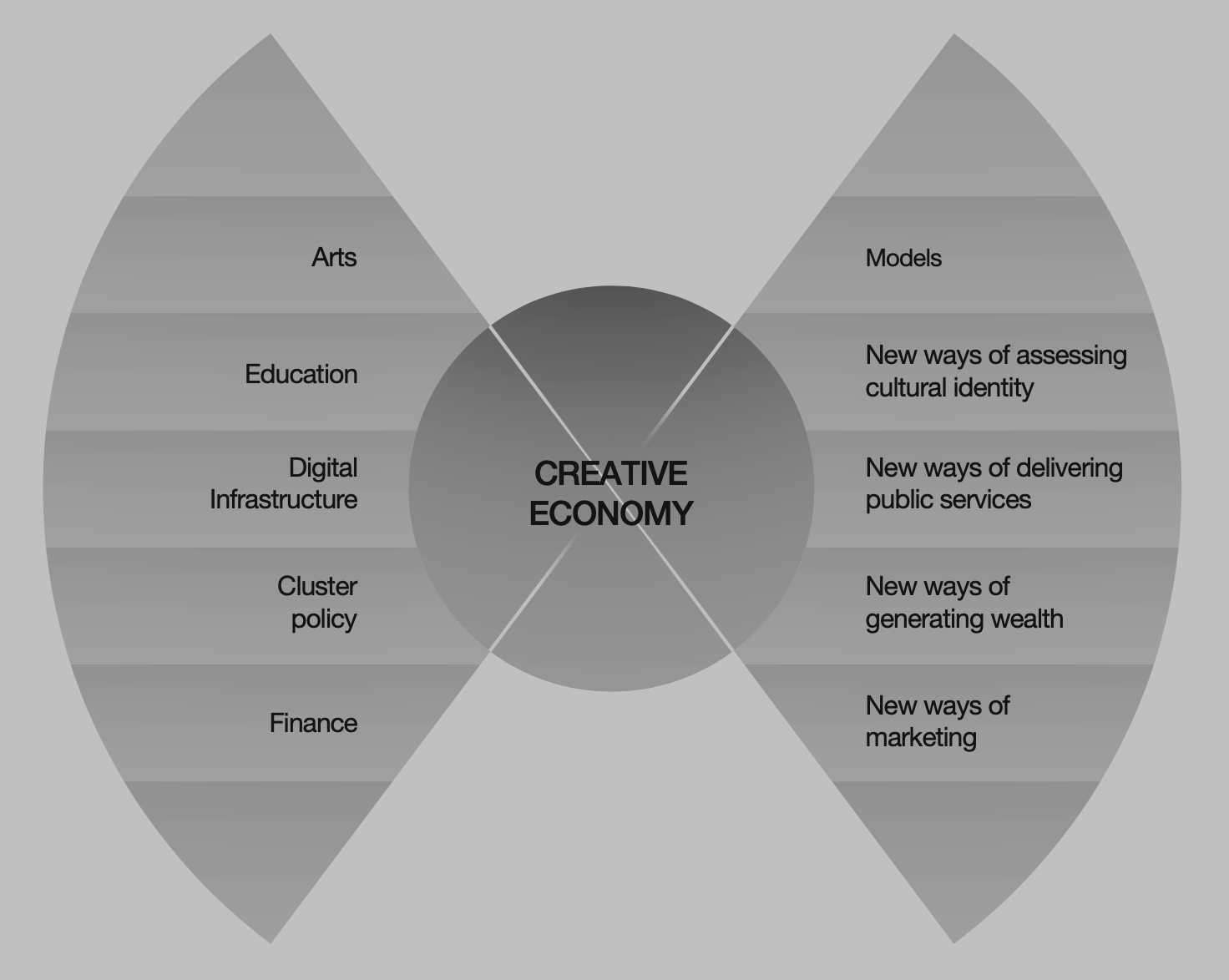
Research Institute performs demand-driven, multidisciplinary research in cooperation with a wide range of companies and organisations ranging from hospitals to newspapers, cultural venues, museums, telco’s, broadcasters, government and of course a large number of technology companies.
As a research institute, we also wish to encourage artists to integrate research in their work, and we expect that this will lead to new ideas, new research, a valuable artistic result and a broader (outside the research community) understanding of each other’s research questions, methods and approaches.
We realise, however, that adapting or creating research, and learning how to work with technology and exploring its possibilities for artistic projects is a time- and money consuming enterprise.
Research focuses on innovation and creativity processes in conjunction with outside resources. This activity explores the most recent thematic fields at the nexus of art and research and maintains strategic networks with a considerable variety of leading academic and artistic institutions.
Our aims at filling the gap between Culture, Academia and Industry by defining, promoting and executing research, development and innovation projects. Within this scenario, the Research Institute has as the main objective to strengthen and increase the know-how of the organisation and its collaborators that will be used as the basis for future innovation projects.
In strong collaboration with several research groups from universities and different companies, we will develop different projects in the scope of the following areas:
Hybrid Space
Investigates the implications and possibilities offered by wireless, mobile media in the hybrid public space.Soft Urbanism
Investigating the interaction between the physical and the digital public domain in contemporary urban networks.Social Engineering
Reflects on old and new forms of the philosophy of social engineering in relation to the urban and social space and to the (communal) life therein.Public Health
Civic ‘wellbeing’. elderly care. eHealth. Artistic and design interventions within health and social care institutions.e Learning
ICT tools for heritage educationMobility, Green ICT, Energy
Education is one of THX’s core tasks. By offering training for the education sectors, THX contributes to the advancement of expertise and media education. THX has much to offer in the areas of elementary and secondary education, as well as academic and professional training. THX participates in scientific research and stimulates debate.
We believe that our role is to seek out and promote new education and training practice in the cultural and creative professions to enhance knowledge and skills, and thus employability in rewarding careers.
We believe that all of our activity should be underpinned where possible by research in areas of both culture and education to foster sustainability in the cultural area.
To bridge the – perceived – gap between education, training, research and professional practice in cultural management.
To embrace the diversity of its partners, promoting good practice, stimulating high-quality education and training, and encouraging cooperation and partnerships.
To build creative partnerships with arts and media organisations, and major stakeholders in the area of culture and education.
THX has developed structural educational programs for all three of its core tasks (presentation, collection and research). These offer a varied selection of activities for different target audiences, such as the general public, secondary schools, professional art education and specialists (artists, art historians and curators). The programs consist of workshops, expert meetings, awards, lectures, activities on the internet and internships.
Research Institute focuses first on professional specialists, but students can also approach it with problems they may encounter. With the aid of the open source and open content principle, as much knowledge and expertise as possible is made available by the internet.
As a result of these projects, the Research Institute will generate a relevant number of publications in magazines, journals and conferences, testbeds, prototypes and field trials.
Visual Media Lab is a forum for the creative and critical discussion of the constantly changing media culture.
It is one of the leading international labs for research and production at the intersection of digital art and information technology.
A center of competence for visual digital technologies, the VML provides an innovative environment for research, development and production in the fields of multi-media art works and information technologies of socio-cultural, scientific and economic significance.
Besides pursuing its own development activities, the collaboration with international guest artists as well as with cultural and research institutions worldwide is a central constituent of the Lab’s activities.
The spectrum of productions ranges from digital video, DVD-production and 3D animation to interactive installations and environments to Augmented and Virtual Reality, from software systems for the real-time generation of natural and architectural environments to audio-visual applications for performance contexts.
The studio for electro-instrumental music is the only independent live electronic music centre in the world that is exclusively dedicated to the performing arts.
Studio supports an international community of performers and musicians, and a growing group of visual artists, to develop unique instruments for their work.
STEIM invites these people for residencies and provides them with an artistic and technical environment in which concepts can be given concrete form. It catalyzes their ideas by providing critical feedback grounded in professional experience. These new creations are then exposed to a receptive responsive niche public at STEIM before being groomed for a larger audience.
AA combines artistic work with research and development and is therefore an international forum for international discourse and exchange. By holding concerts, symposia and festivals on a regular basis it brings together composers, musicians, musicologists, music software developers and listeners interested in contemporary music.
Artists in Residence and software developers work on their productions in studios at the lab. With digital sound synthesis, algorithmic composition, live-electronics up to radio plays, interactive sound installations and audiovisual productions their creations cover a broad range of what digital technology can inspire the musical fantasy to.
Despite the technical orientation, musical and artistic work is always put first at the lab for Music and Acoustics, which is one of the reasons it is so widely appreciated in the musical world. The aesthetic spectrum of projects realised at the lab is not only limited to the paradigm of >New Music< in the sense of the twentieth century. Even if the roots of many projects lay there, the lab views itself as a base for all musical approaches which pursuit with open ears towards new tendencies and technologies in music.
For many productions, the lab of Audio and Acoustics cooperates with related institutions, festivals, ensembles and broadcasting. The Labs own artist-in-residency program often additionally supported by foundations or by collective commissions with other institutions.
The Montveideo Preservation Lab is the unique research facility in Europe. Here methods are developed to restore decades old videotape and rare tape cassette formats which are largely no longer playable. With equipment consisting of more than 300 devices, the laboratory is in the position to convert almost 50 various video formats into high-quality digital form and so secure them for the long-term.
The goal of the laboratory is the scientific restoration, preservation and archival storage of the Institutes singular holdings with the help of equipment from private and public sources: a digital Noah’s Arch that saves media art from vanishing.
Works of video art that in many cases have not been showable for more than 30 years, or only in bad copies, can now be seen again in their original quality. The same is true of rare video documentation of art events from the 1960s and 70s. The rescued audio-visual material is made available to the public at exhibitions, in DVD editions and in the collections of the Institute.
Creative Engineering is a group of technology-enthusiastic software and web developers which play a considerable role in the conceptualization and realization of the labs and research projects. The tasks revolve around the center of human-machine-communication, i. e. the areas of computer graphics, computer vision and the integration of forward-looking and/or experimental hardware.
Between technology enthusiasm and engineering discipline, a creative engineer’s motive force consists of enthusiasm for a creative environment and the constant communication within the team.
The Artist in Residence (AiR) programme supports the exploration and development of new work in digital/interactive/network media and technology based arts practice. The residency provides time and resources to artists in a supportive environment to facilitate the creation of new work. We encourage a cross disciplinary and experimental approach. This is a practice based residency designed to enable the development and completion of a new work.
The Center offers an open environment with technical assistance and an active advisory board which will give feedback and support in technical, conceptual and presentation issues. There is access to studio and exhibition equipment, technical support from the Center’s staff and production help from interns. We expect the artist to have knowledge and insight in the technical realization of the concept.
Partners
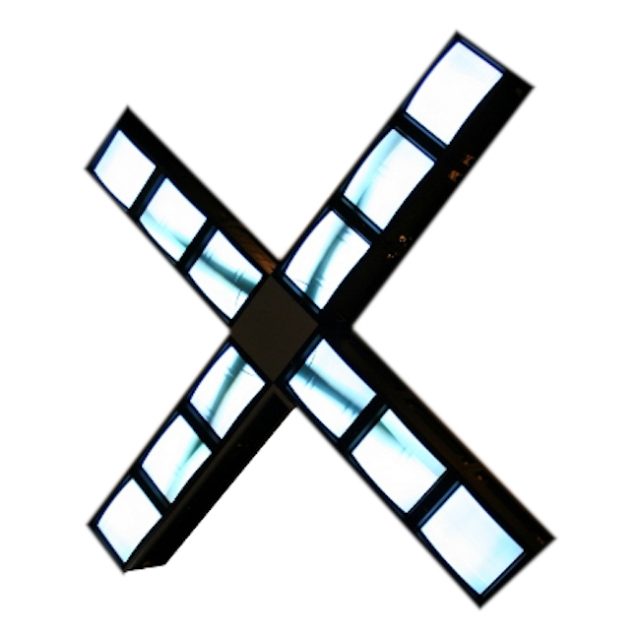
Industry
Siemens
WitteveenBos
Nissan
Universities
Royal Art Academy
Royal Conservatory
Institue of Sonology
Hotelschool The Hague
The Hague University of Applied Sciences
STT – StichtingToekomstbeeld der Techniek
TU Delft
Universtity of Amsterdam
Rijksacademie
MIT
KABK – Art Science – Interactive Media Design, Textiel en Mode
ARLAB – Augmented Reality Lab
Koninklijke Conservatorium
Institute of Sonolgy
STT – StichtingToekomstbeeld der Techniek
Haagse Hogeschool
Presentation
Stroom
TAG
EYE Film Institute
WORP
Groningen Museum
Erfgoed Nederland
De Appel
SMART project space
Mama
Gallerie West
Theater aan het Spui
Filmhuis
Korzo Theatre
Paard van Troj
Gemeentemuseum – GEM
Crossing Border
Cadance
State X
Dag in de Branding


